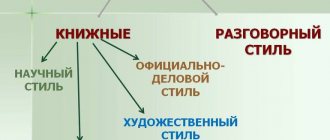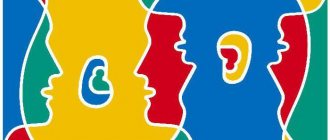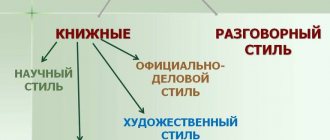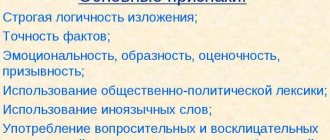In the modern Russian literary language, there are 5 functional styles of speech: colloquial, journalistic, official business, artistic and scientific style of speech.
In this article we will analyze in detail the scientific style of speech. You will find answers to the following questions:
- what is scientific style of speech;
- its main function and tasks;
- scope of application;
- features and characteristics of the scientific style;
- substyles or varieties;
- genres of scientific style of speech;
- example of a scientific text.
What is the scientific style of speech, its functions and tasks
The scientific style of speech is a functional style of speech of the Russian literary language, which is a means of communication in the field of scientific, scientific-professional and educational-scientific activities.
The main function of the scientific style of speech is informative. It consists in conveying objective information about man, nature, and society.
The task of the scientific style is to explain natural and social phenomena, identify patterns and identify cause-and-effect relationships.
Scientific style texts are distinguished by clarity, logic, accuracy, objectivity and evidence-based presentation of information.
Scope of application of scientific style
The scope of application of the scientific style of speech is the field of science and educational and scientific activity.
First of all, it is used in written form of speech: textbooks, articles, dissertations, reports, encyclopedias, etc. But it is also found in oral form (for example, during scientific conferences).
To design presentations, printed materials, and publications, I recommend using Canva. This is a very simple and convenient all-in-one visual editor. With thousands of professional templates, images, and other quality elements, you'll get a great starting point to bring your best ideas to life.
Main features and characteristics of the scientific style of speech
The features and characteristics of the scientific style include:
- Logical presentation - information is presented consistently and in a clear sequence.
- Generality, accuracy and objectivity in the presentation of information.
- Evidentiary and rich presentation (many arguments, facts).
- Application of terms and general scientific words. On average, terms occupy about 15-20% of the total text volume.
- The use of words with an abstract meaning (these are words that do not evoke specific images in the mind and memory, for example: property, essence, worldview, reality).
- Most often there is a monologue character of speech.
- More nouns and adjectives, and a minimum of verbs.
- Complex sentence construction.
- The sentences are mostly long.
- Practically no means of expression are used (epithets, comparisons, metaphors, etc.) and there is no expressive-emotional vocabulary (admirable, son, inspire, despise, sycophant).
- Correct word order.
- Strict sequence of presentation.
Specificity of scientific information
So, what features of scientific style are associated with the specifics of scientific information:
- Terminology . Any science has its own terminological and conceptual apparatus. All these concepts and terms are contained and explained in special dictionaries. But scientific texts are designed for those who are already familiar with the terminology. Therefore, the terms are not explained in the texts themselves.
- Accuracy . One of the fundamental properties of science, reflected in the text. Not only words (lexical and phraseological units), but also wording must be accurate. This, of course, does not exclude metaphors or any emotional markers in the text, but makes their use extremely narrow and almost always requires justification.
- Logical sequence . A property that relates not to individual linguistic units, but to the text as a whole. Logical consistency ensures sound scientific argumentation.
- Unambiguity . Many words in the language have such a property as polysemy - polysemy. We often use it in colloquial speech, writers love to resort to it in literary texts. But in science, polysemy is very often a harmful phenomenon; it destroys the accuracy of scientific statements. Therefore, even if you use polysemantic words, try to make sure that the meaning you intend is clear from the context.
Scientific style of speech: its varieties or substyles
Like other styles of speech, the scientific style is rarely found in its “pure” form. Scientific texts may contain elements of both journalistic and official business style of speech.
Because of this interaction with other styles of speech, and depending on the purpose and specific application, the scientific style is divided into 6 substyles :
- Proper scientific or academic: dissertations, reports, communications, monographs, speeches;
- Educational and scientific: textbooks, lecture courses, course work, seminar report;
- Popular science: popular science books and magazines, children's encyclopedias;
- Scientific and informative: abstracts, reviews, summaries, theses;
- Scientific reference: encyclopedias, dictionaries, reference books;
- Scientific and technical: patents, standards, descriptions of inventions, specifications, technical conditions.
| Substyle name | Target | Genres |
| Actually scientific | Definition and description of new phenomena, facts, patterns. | dissertations, reports, communications, monographs, speeches, scientific articles. |
| Educational and scientific | Transferring scientific information to students, teaching, describing the facts necessary for mastering and mastering the material. | textbooks, lecture courses, course work, seminar report, notes, oral response. |
| Popular science | Familiarization with facts and phenomena. | popular science books and magazines, children's encyclopedias, articles. |
| Scientific and informative | Transmission of scientific information with a description of scientific facts. | abstracts, reviews, theses. |
| Scientific reference | Providing the reader with the ability to quickly find the necessary scientific information. | encyclopedias, dictionaries, reference books. |
| Scientific and technical | Application of scientific achievements in practice. | patents, standards, descriptions of inventions, specifications, technical conditions. |
Substyles (varieties) of scientific style of speech and examples of genres
Step 1: what is actually being stated here?
Any explanation of complex material, be it a school lesson or a scientific publication, begins with the formulation of a certain statement, which is then explained, proven, and illustrated with examples. Therefore, the first level of understanding is when the reader realizes what is actually being asserted here. And situations of complete misunderstanding often come down to the fact that a person simply does not grasp the very essence of the statements, and hears something other than what they are trying to convey to him.
For example, a popular question is: “Why can’t you divide by zero?” - a typical example of a misunderstanding of the statement itself left over from school.
A person thinks that he is forbidden to divide, forbidden to take one extra step and further determine the division process. He demands to be allowed and asks what the answer will be. But the real statement is completely different: any one-step additional definition will lead to an internally contradictory construction. You cannot assign the result of the operation 1/0 to any real number, because then you would violate the multiplication axioms established for all real numbers. You can designate the result with a new word "infinity", but this is only the first step. After all, next you will need to introduce rules for working with this infinity, which will differ from the rules for working with ordinary numbers, determine what equals infinity multiplied by zero, and decide how many “infinities” you will enter. No matter how you twist it, you will end up with a new number system with its own strange rules. It is this fact that is expressed by the phrase “you cannot divide by zero.”
Here’s an example from an academic environment: a person gives a report, and the entire audience looks at the slides with an unblinking, dazed gaze in complete silence. If you pull the listener out in this state and ask him to immediately say something about any of the slides, then after several minutes of torment he will begin to ask: what is this letter? what is this term? Where does this formula even come from? Here we have a classic example of a person - and perhaps the entire audience - not understanding what is being said at all. Let me emphasize that the problem here is not that the presentation is boring. The listener tries to follow the presentation, but if he missed something important from the very first minutes, he may completely cease to understand what is being said.
I am convinced that the first level of understanding is available to the interested listener on any scientific topic. He may not know the terminology or understand the technical details, but if you formulate in clear, simple words what was essentially done here, he will understand it.
Therefore, any popular science text should strive to convey to its readers the main idea at least at this first level of understanding. If the typical reader, a representative of the target audience, does not understand what it is about at all, the mission of the news will fail, no matter how smart the text itself may sound.
Here, for example, is a paragraph from a very short news story written in complex language:
“It turned out that in such a system it is impossible to obtain a completely conducting state in which single Dirac points would appear (the reason is again symmetry). However, such materials may be topological insulators or Weyl phases. The first are characterized by the fact that they have a conducting surface, but remain insulators in the bulk, and in the second, conducting quasiparticles arise that behave as if they have no mass.”
Do you understand right away what is possible, what is impossible and why? This paragraph will, of course, be clear to a specialist in condensed matter physics, but not to a non-specialist reader. In this paragraph there is such a high concentration of terms per line of text; they are introduced so quickly and with such meager explanations that the reader is simply unable to digest them.
Genres of scientific style of speech
Genres of scientific style are types of scientific texts that differ in their structure and functions.
There are several classifications of genres of scientific style. For example: primary and secondary scientific works or genres with free (articles, reviews) and with a fixed writing structure (dissertation).
In this article we will consider the classification of genres depending on the specific communicative and information functions that they perform.
Scientific style of speech: genres of the scientific substyle
The main function of this substyle is to identify and describe original research results, to present new facts, phenomena and patterns.
Genres of the scientific sub-style include:
- A monograph is a scientific study devoted to one specific phenomenon, fact, issue or topic. The volume of the classic text of the monograph is more than 120 pages in A4 format. This is a full-fledged scientific work.
- A scientific article is a short essay in which the author describes the results of his own research.
- A dissertation is a qualifying work, the successful completion of which is necessary for the award of an academic degree. Volume: from 50 to 500 pages. Available in the form of a book or bound manuscript.
Genres of this substyle also include reports, messages, and speeches.
Texts of the proper scientific substyle have a general writing structure, which includes:
- Name.
- Introduction.
- Main part.
- Conclusion.
Genres of educational and scientific substyle
Educational and scientific speech is used in the learning process, namely for the transmission and development of scientific information by students.
There are oral and written genres of educational and scientific substyle. Oral ones include: message and response .
The main written genres of this substyle are:
- A report is a detailed message on a specific issue, based on documentary data. The purpose of the report is to inform and provide recommendations or suggestions.
- A textbook is a teaching tool designed to assimilate, deepen and expand knowledge.
- Note - a summary or brief recording of a lesson, lecture, article.
- A course of lectures is a collection of lecture texts by one or more authors on individual topics or on the course as a whole. Covers the content of the academic discipline.
Popular science genres
This substyle is intended to disseminate scientific information among the mass recipient (for example, among a certain category of readers - children, teenagers, etc.).
Popular science genres include:
- Popular science books are literary works about science, scientists, scientific achievements and research, intended for a wide range of readers.
- Popular science magazines.
- Children's encyclopedias.
- Articles.
Genres of the scientific and information substyle
The function of the scientific information substyle is to convey scientific information.
The main genres of this substyle:
- An abstract is a short report on a specific topic, which collects information, most often from several sources.
- A review abstract is a report that compares different points of view on a particular issue. Compiled based on several sources.
- An abstract is a short report that outlines only the main points.
- The thesis is the leading genre of scientific style. It is a short record that outlines the main points of scientific research.
Genres of scientific reference substyle
The task of the scientific reference sub-style is to provide the reader with the ability to quickly find the necessary scientific information.
The main genres of the scientific reference substyle are:
- Encyclopedia is a scientific reference review of all or individual branches of knowledge in the form of a dictionary.
- A dictionary is a collection of words with their translation, interpretation and explanation.
- A reference book is a book that contains brief information of a scientific, social, industrial or applied nature.
- Catalog is a list of information about objects, the purpose of which is to facilitate the search for these objects by a certain criterion.
Scientific style of speech: genres of the scientific and technical substyle
The scientific and technical substyle is common in technical documentation. The texts of this substyle serve to apply in practice all the achievements that have been obtained as a result of theoretical and experimental scientific research.
The genres of the scientific and technical substyle include:
- A patent is a document certifying the exclusive right to an invention, product or process.
- Specification is a definition and list of specific features, a refined classification of something.
- Technical specifications are a document establishing the technical requirements that a specific product, material, substance, etc., or a group of them must meet.
- Standards.
- Description of inventions.
Popular science style
This type of scientific style is used to popularize scientific discoveries and achievements. The authors of the popular science style in a fascinating and entertaining way tell about space and mysterious planets, about the life of animals and plants, about the secrets of the seas and oceans, that is, about everything that interests inquisitive readers.
The popular science style retains the main features of the scientific style. It uses terms and abstract nouns. Verbs are dominated by third person singular forms. But unlike other types of scientific style, the text uses colloquial and emotionally expressive vocabulary. To enliven the narrative, figurative means are used (epithets, comparisons, various types of repetitions), and the monologue sometimes takes on the features of a dialogue.
Structure of scientific text
Any scientific text, regardless of genre, is built according to a single logical scheme.
The basis is always a thesis - a statement that requires justification. To confirm and substantiate this thesis, the text must present argumentation and provide evidence . Often, for a more complete argument, illustrations - examples that confirm the scientific assumptions put forward.
The text ends with a conclusion or summary , which outlines an assessment of the research conducted and also presents prospects for further study.
An example of texts written in a scientific style of speech
“A tornado is a strong small-scale vortex that arises in a thunderstorm (cumulonimbus) cloud and spreads in the form of a dark “trunk” towards the water or earth’s surface.
In the upper part, below the lower boundary of the cloud, the vortex has a funnel-shaped expansion. The barrel of a tornado descends to the earth's surface, its lower part, in contact with it, takes the form of an overturned funnel. The height of a tornado can reach 800–1500 m. The air in it rotates most often counterclockwise, rising in a spiral upward, drawing in dust or water, and fragments of objects destroyed on the ground.
The air rotation speed can reach 50–100 m/s with a strong upward component and cause catastrophes. destruction, sometimes accompanied by loss of life. At the same time, near his path there may be complete calm. Inside the tornado, the air pressure decreases, condensation of water vapor occurs there, which, together with the elongated part of the cloud, dust, water and decomposition. the debris makes death visible. Its axis is vertical, but often has a curved appearance.”
Electronic encyclopedia
» Existing territorial planning schemes for environmental management do not contribute to the creation of environmentally-oriented economic activities, which leads to conflict situations between economic entities both within the Kaliningrad region and outside it. Analysis of the features of socio-economic development and environmental policy made it possible to identify a number of significant methodological and methodological shortcomings in territorial planning and development. In particular, the development of the Kaliningrad region is carried out on the basis of poorly coordinated and poorly environmentally oriented departmental plans: urban planning, agricultural, reclamation, water, forest management, recreational and others.
Environmentally-oriented landscape planning can help in solving problems of territorial development. The landscape program of the Kaliningrad region is a strategic planning document for the use of the territory, forming an information and reference field for a wide range of organizations and officials responsible for the development and adoption of management territorial planning decisions, as well as state and non-state environmental and environmental funds, international organizations in the field of environmental control and management.
One of the most important tasks in implementing the program is the development of an integrated map of environmentally-oriented use of the territory and a map of environmental management conflicts. Solving these problems without the use of geographic information technologies is very complicated and sometimes impossible.”
Excerpt from the scientific article “Introduction of open geoinformation technologies into environmental planning methods”
Information sources:
- Russian language for technical universities. Scientific style. Author: Yu. Smirnova
- Wikipedia
- Russian language and culture of speech. Authors: Tatyana Balykhina, Mikhail Rybakov, Marina Lysyakova.
- Stylistics of scientific speech and editing of educational and methodological materials. A textbook for teachers and educators of the secondary education system.
- Photo on the cover of the article - science.sciencemag.org
PS: Did you like the article? Share the link on social networks, thank you!
Research level
The higher rungs of this ladder of levels of understanding already relate to research work. On them, a person is able to develop new knowledge himself. However, here too there is a gradation of levels of understanding.
Stage 4 is when you are able to generate understanding on your own. You can go further than you were told, you ask yourself questions and, overcoming technical difficulties, come to the answers. You not only see each step in the chain of arguments, but also understand what will happen if you change it. You can feel the limits of applicability of this chain.
Level 4 is, in general, the routine level of deep but technical immersion in the topic, the level of a good teacher of the subject. You can come up with new learning tasks, but all your ideas will remain within the standard picture and will be based on standard tools. But for fruitful scientific work, you need to rise one step higher - to where you begin to generate ideas, develop theories, and come up with new experimental setups. This doesn’t happen blindly, it doesn’t happen overkill, it’s the result of your accumulated experience in a certain area.
And finally, above all this there is the “epiphany mode” - the ability to make an unexpected leap of understanding that does not in any way follow from uniform research around the issue. Understanding at this level is when you, using either professional intuition or purposefully going beyond the boundaries of your task, suddenly find a non-trivial connection with some other, at first glance, extraneous statement. You formulate a completely new view of things - and numerous consequences immediately follow from it. To do this, a certain “voice” must sound in your head, asking very unexpected questions or offering to try something completely new.
If we return to Richard Feynman's phrase that no one really understands quantum mechanics, it becomes obvious that Feynman was talking about misunderstanding at the very top of the ladder.
Of course, physicists understand the technical aspects of quantum mechanics. But, speaking in the most general terms, physicists do not have a generally accepted understanding of why quantum mechanics should be implemented in our world at all, why our world cannot do without it, why other hypothetical forms of the fundamental laws of the microworld are not implemented.
Therefore, when you come across this Feynman quote as “proof” that quantum mechanics is incomprehensible, contradictory, incomprehensible to a normal person, know that the author giving the quote does not fully understand this statement. He probably does not understand it even at the level of the first step.
Book we recommend:
Igor Ivanov










